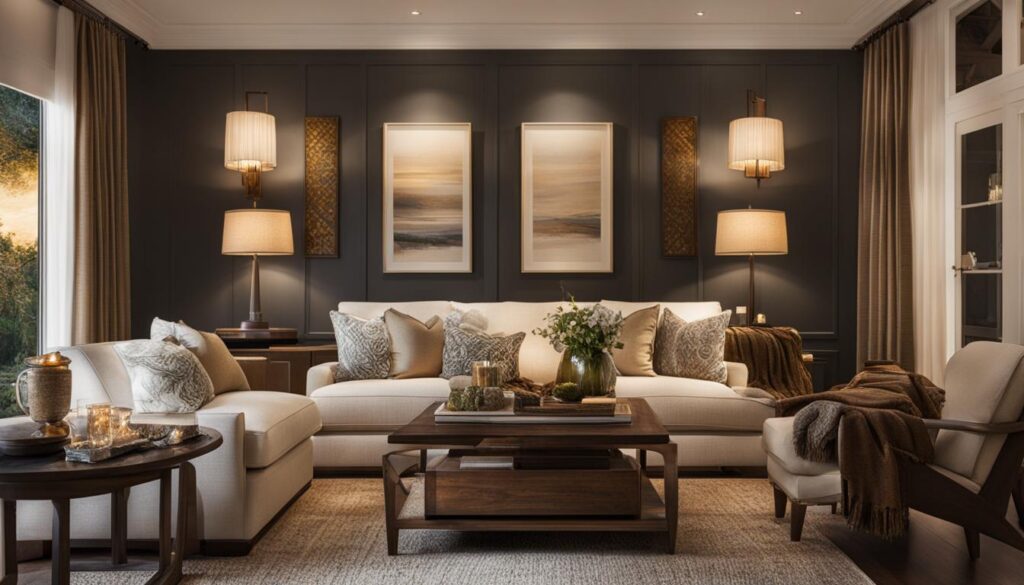When it comes to lighting your living room, finding the right amount of lumens is crucial for creating a comfortable and inviting space. Lumens determine the brightness of a light bulb, and knowing how many lumens are needed for your living room can help you achieve the perfect balance of light. In this article, I will guide you through the process of calculating the ideal number of lumens for your living room, as well as provide valuable tips for achieving the perfect ambiance through lighting layering.
Table of Contents
Key Takeaways:
- Calculating the total lumens needed for a living room requires determining the square footage and referring to a footcandle chart.
- Consider variables such as ceiling height and wall color when determining the ideal number of lumens.
- Understanding lumens and watts is important for choosing the right light bulb.
- LEDs provide higher CRI but do not necessarily provide more light than incandescent bulbs.
- Layering different types of lighting, such as task lighting, ambient lighting, and accent lighting, helps create the perfect ambiance in your living room.
Understanding Lumens and Watts
When it comes to choosing the right lighting for your living room, understanding the concepts of lumens and watts is essential. Lumens measure the total brightness or light output of a light source, while watts indicate the amount of energy consumed by a light bulb to produce that light output. It’s important to note that lumens and watts are not directly correlated, and different types of light sources have varying lumen-per-watt ratios.
For example, traditional incandescent bulbs have lower lumen-per-watt ratios compared to newer LED bulbs. This means that LED bulbs can provide the same amount of light output as incandescent bulbs while consuming less energy. Considering the efficacy, or lumens per watt, can help you choose energy-efficient lighting options for your living room.
Efficacy is an important factor to consider when selecting light bulbs. It refers to the amount of light produced by a bulb for each watt of energy it consumes. Lighting products with an ENERGY STAR label typically have high efficacy, indicating that they provide more lumens per watt and are more energy-efficient. By choosing bulbs with high efficacy, you can save on energy costs while still achieving the desired level of brightness in your living room.
“Lumens measure the total brightness or light output of a light source, while watts indicate the amount of energy consumed by a light bulb to produce that light output.”
When it comes to determining the ideal number of lumens for your living room, it’s also important to consider other factors such as ceiling height, wall color, and personal preference. These factors can affect the perceived brightness and overall ambiance of the room. Consulting a lighting design professional can help you make an informed decision based on your specific room requirements and desired lighting effects.
| Bulb Type | Average Lumens | Efficacy (Lumens per Watt) |
|---|---|---|
| Incandescent | 700 – 1,200 | 10 – 17 |
| LED | 800 – 1,600 | 50 – 100 |
| CFL | 800 – 1,600 | 55 – 80 |
This table provides a general reference for the average lumens and efficacy of different bulb types. Keep in mind that specific bulb models may vary, so it’s always best to check the packaging or consult the manufacturer for accurate information on lumen output and efficacy.
Layering Light for the Perfect Ambiance
The key to creating the perfect ambiance in a living room is by layering different types of lighting. By combining task lighting, ambient lighting, and accent lighting, you can achieve a beautiful and versatile space that suits your needs and preferences.
Task lighting is essential for specific activities such as reading, working, or any task that requires focused illumination. It typically requires a higher amount of lumens to ensure proper visibility. Incorporating desk or table lamps strategically placed near work areas or reading nooks can provide the necessary task lighting.
Ambient lighting refers to the overall level of light in a room. It sets the mood and provides general illumination. To achieve ambient lighting in your living room, consider using a pendant light or chandelier as the main light source. Complement it with floor lamps, wall lights, and table lamps strategically placed around the room to distribute light evenly.
Accent lighting is used to highlight specific areas or objects in the room, adding depth and visual interest. It can be achieved by using recessed lights, uplighters, or even adjustable spotlights to draw attention to architectural features or artwork. Accent lighting helps create a focal point and adds a layer of sophistication to your living room design.
Remember to use dimmers to adjust the light levels according to your personal preference and desired atmosphere. This allows you to create different moods and adapt the lighting to various activities throughout the day. With proper layering of light, your living room will become a versatile and inviting space for relaxation, entertainment, and everything in between.
FAQ
How do I calculate the number of lumens needed for a living room?
To calculate the lumens needed, determine the square footage of the room and refer to a footcandle chart to find the footcandle requirement. Multiply the square footage by the footcandle requirement to calculate the total lumens needed.
Can I use a lumen calculator to estimate the lumens needed for a living room?
Yes, a lumen calculator can provide an estimate of the lumens needed. However, it’s best to consult a lighting design professional for an exact analysis, considering variables such as ceiling height, wall color, and personal preference.
What is the difference between lumens and watts?
Lumens measure the total quantity of visible light emitted by a light source, while watts measure the amount of electricity or energy a light bulb consumes. Different types of light sources have different lumen-per-watt ratios.
How do I choose the right light bulb for a living room?
Consider the lumen-per-watt ratio and efficacy of the light bulb. LEDs, for example, provide higher Color Rendering Index (CRI) but do not necessarily provide more light than incandescent bulbs. Look for lighting products with an ENERGY STAR label, as they are high efficacy and use less energy.
How can I create the perfect ambiance in a living room?
Layer different types of lighting, such as task lighting, ambient lighting, and accent lighting. Task lighting is used for specific tasks, while ambient lighting refers to the overall level of light in a room. Accent lighting is used to draw attention to specific areas or objects. By combining these three types of lighting, you can create different moods and effects in your living room.


